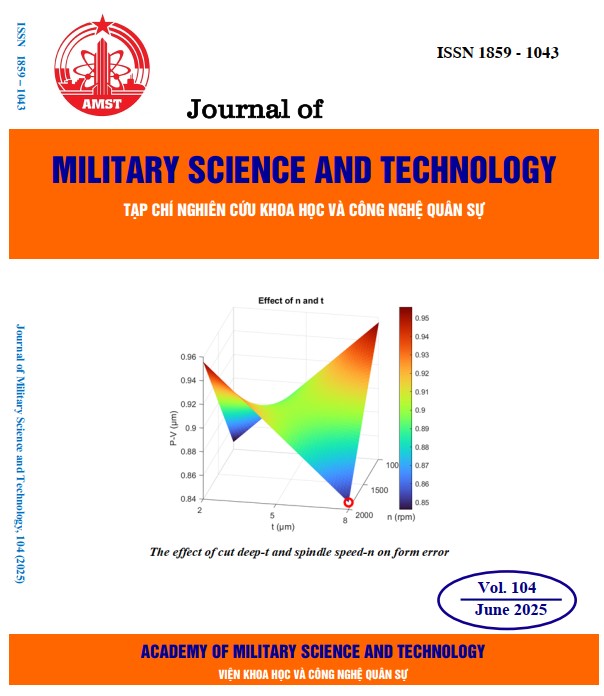Tổng hợp chất kết dính trên nền phosphate từ xỉ nhôm cho lớp phủ vô cơ chịu nhiệt
234 lượt xemDOI:
https://doi.org/10.54939/1859-1043.j.mst.104.2025.87-93Từ khóa:
Xỉ nhôm; Chất kết dính phosphate; Lớp phủ vô cơ; FTIR; Độ nhớt; Tái sử dụng chất thải.Tóm tắt
Nghiên cứu này trình bày quy trình tổng hợp và tối ưu hóa chất kết dính poly aluminum phosphate (PAP) từ xỉ nhôm – một phế thải công nghiệp giàu Al₂O₃. Phản ứng axit–bazơ giữa xỉ nhôm và axit photphoric (H₃PO₄) được thực hiện ở các điều kiện khác nhau về tỷ lệ mol Al/P, nhiệt độ và tốc độ khuấy để khảo sát ảnh hưởng đến độ nhớt, độ bám dính và cấu trúc gel. Kết quả chỉ ra rằng điều kiện tối ưu là 30% xỉ nhôm, 70% H₃PO₄, nhiệt độ 60–70 °C và tốc độ khuấy 800 vòng/phút. Sản phẩm thu được là gel đồng nhất, có độ nhớt cao (~101 mPa·s), tỷ trọng 1.46 g/cm³ và độ bám dính 100%, đáp ứng tốt yêu cầu làm lớp phủ chịu nhiệt. Phân tích FTIR xác nhận sự hình thành liên kết Al–O–P và chuỗi polyphosphate, trong khi ảnh chụp SEM và phổ EDS cho thấy cấu trúc vi mô đồng nhất và độ tinh khiết cao. Kết quả nghiên cứu khẳng định tiềm năng tái sử dụng xỉ nhôm để sản xuất chất kết dính vô cơ hiệu suất cao, góp phần thúc đẩy phát triển vật liệu thân thiện môi trường.
Tài liệu tham khảo
[1]. Li, Y., Chen, G., Zhu, S., Li, H., Ma, Z., Liu, Y., & Liu, L. “Preparation of an aluminium phosphate binder and its influence on the bonding strength of coating”. Bulletin of Materials Science, 42, (2019). https://doi.org/10.1007/s12034-019-1912-3 DOI: https://doi.org/10.1007/s12034-019-1912-3
[2]. Zhang, B., Gong, W., Li, X., Chen, P., & Zhu, B. “Optimized microstructure with alumina micro pow-der and its effects on properties of phosphate-bonded castables”. International Journal of Materials Research, 110, 765–772, (2019). https://doi.org/10.3139/146.111796 DOI: https://doi.org/10.3139/146.111796
[3]. Le, C. M., & Le, T.-H. “The study’s chemical interaction of the sodium silicate solution with extend-er pigments to investigate high heat resistance silicate coating”. Journal of Analytical Methods in Chemistry, Article ID 5510193, (2021). https://doi.org/10.1155/2021/5510193 DOI: https://doi.org/10.1155/2021/5510193
[4]. Vinh, L. T. “Thermal resistance and heat durability of inorganic coatings”. Journal of Chemistry (Vietnam), 48(4A), 485–488, (2010).
[5]. Cai, G., Wu, J., Guo, J., Wan, Y., Zhou, Q., Zhang, P., Yu, X., & Wang, M. “A novel inorganic alumi-num phosphate-based flame retardant and thermal insulation coating and performance analysis”. Materials, 16(13), 4498, (2023). https://doi.org/10.3390/ma16134498 DOI: https://doi.org/10.3390/ma16134498
[6]. Chung, D. D. L. “Acid aluminum phosphate for the binding and coating of materials”. Journal of Materials Science, 38(12), 2785–2791, (2003). DOI: https://doi.org/10.1023/A:1024446014334
[7]. Mikhailova, A., et al. “Refractory cellular concrete based on phosphate binder from aluminum slag”. Procedia Engineering, 206, 1376–1381, (2017). https://doi.org/10.1016/j.proeng.2017.10.698 DOI: https://doi.org/10.1016/j.proeng.2017.10.551
[8]. Li, Y., et al. “Creation of self-hardening aluminum phosphate binders for protective fire-resistant coatings”. Journal of Building Engineering, 69, 106523, (2023). https://doi.org/10.1016/j.jobe.2022.106523
[9]. Zhang, B., et al. “Effect of Al₂O₃-MWCNTs on anti-corrosion behavior of inorganic coatings”. Sur-face and Coatings Technology, 460, 128524. (2023). https://doi.org/10.1016/j.surfcoat.2023.128524
[10]. Vippola, M., Keränen, J., Zou, X., Hovmöller, S., Lepistö, T., & Mäntylä, T. “Structural characteriza-tion of aluminum phosphate binder”. Journal of the American Ceramic Society, 83, 1834–1836, (2000). https://doi.org/10.1111/j.1151-2916.2000.tb01477.x DOI: https://doi.org/10.1111/j.1151-2916.2000.tb01477.x
[11]. Zhang, B., et al. “Phosphate activated geopolymer-based coating with high thermal stability”. Journal of Building Engineering, 69, 106523, (2023). https://doi.org/10.1016/j.jobe.2022.106523
[12]. Huo, S., Dong, Z., Li, X., Liu, P., Chen, P., & Zhu, B. “Preparation of a modified multi-component phosphate adhesive for connection of 316L stainless steel and its reinforcement mechanism”. Inter-national Journal of Adhesion and Adhesives, 125, 103437, (2023). https://doi.org/10.1016/j.ijadhadh.2023.103437 DOI: https://doi.org/10.1016/j.ijadhadh.2023.103437
[13]. Li, J., Liu, J., Zhang, Y., Wan, Y., Liu, J., Cai, G., Tao, X., Jing, W., & Wang, M. “Preparation and properties of high-temperature resistant inorganic phosphate-based adhesive for connecting quartz glass at elevated temperatures”. Ceramics International, (2024). https://doi.org/10.1016/j.ceramint.2024.08.440 DOI: https://doi.org/10.1016/j.ceramint.2024.08.440
[14]. Qi, C., Ji, X., Li, J., Hu, Z., Wei, X., Xiao, B., & Wang, M. “The preparation and performance analysis of high-entropy phosphate high-temperature resistant adhesives”. Journal of the European Ceramic Society, 45, (2025). https://doi.org/10.1016/j.jeurceramsoc.2025.117356 DOI: https://doi.org/10.1016/j.jeurceramsoc.2025.117356
[15]. Wang, M., Li, K., Lu, R., Feng, Z., Wei, T., Zhou, Q., & Zhai, W. “Advanced high-temperature re-sistant (RT-1000 °C) aluminum phosphate-based adhesive for titanium superalloys in extreme envi-ronments”. Ceramics International, 47, 32988–33001, (2021). https://doi.org/10.1016/j.ceramint.2021.08.199 DOI: https://doi.org/10.1016/j.ceramint.2021.08.199
[16]. Wang, M., Zhang, J., Tong Wei, Zhou, Q., & Li, Z. “Effect of Al:P ratio on bonding performance of high-temperature resistant aluminum phosphate adhesive”. International Journal of Adhesion and Adhesives, 100, 102627, (2020). https://doi.org/10.1016/j.ijadhadh.2020.102627 DOI: https://doi.org/10.1016/j.ijadhadh.2020.102627
[17]. Wang, M., Dong, X., Zhou, Q., Feng, Z., Liao, Y., Zhou, X., Du, M., & Gu, Y. “An engineering ceram-ic-used high-temperature-resistant inorganic phosphate-based adhesive self-reinforced by in-situ growth of mullite whiskers”. Journal of the European Ceramic Society, 39, 1703–1706, (2019). https://doi.org/10.1016/j.jeurceramsoc.2018.12.040 DOI: https://doi.org/10.1016/j.jeurceramsoc.2018.12.040







